Affiliate disclosure: This post may contain affiliate links. Please see our Privacy Policy.
Whether making freeze-dried bell peppers or freeze-dried spicy peppers, these crunchy little nuggets are great for preserving your summer harvest. Jalapenos, chilis, poblanos, and sweet peppers are all great candidates for freeze-drying.
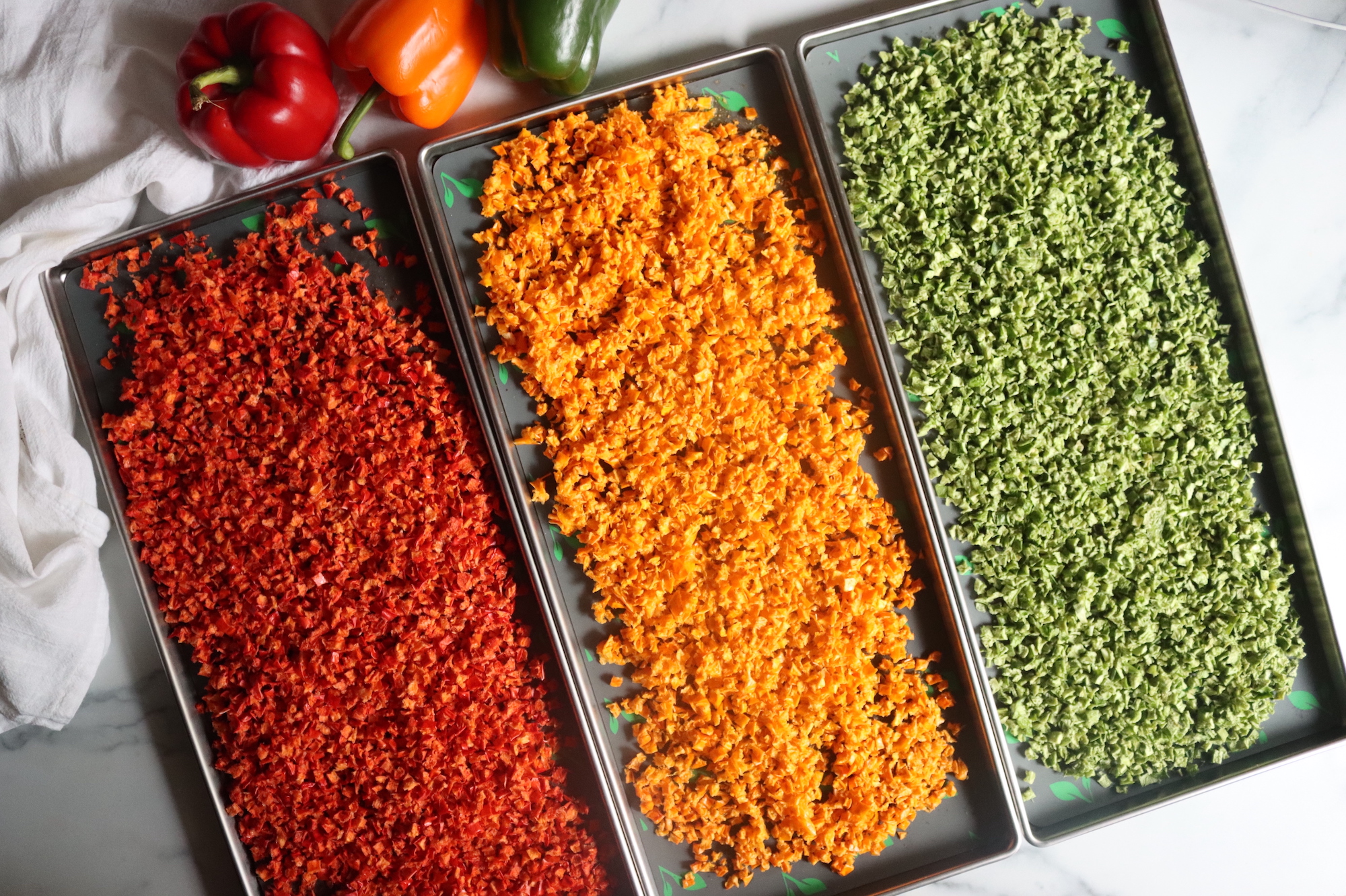
Table of Contents
- What’s the Difference Between Freeze Dried Peppers and Dehydrated Peppers?
- Best Peppers to Freeze Dry
- Freeze Dried Peppers Yield
- Supplies Needed
- Preparing Peppers for Freeze Drying
- How to Freeze Dry Peppers
- Reconstituting Freeze Dried Peppers
- How Do Freeze Dried Peppers Taste?
- How to Store Freeze Dried Peppers
- How Long Do Freeze Dried Peppers Last?
- Ways to Use Freeze Dried Peppers
- Freeze Dried Peppers (Hot or Sweet) Recipe
- Freeze Drying Guides
How do you keep fresh peppers on hand all year long? Freeze-drying, of course! Freeze-drying peppers is a perfect way to pack up that summer bounty and preserve it for a rainy day.
While there are many methods for preserving peppers like canning peppers and pickling peppers, some of the original fresh flavor of peppers is lost in the process. They also really decline in texture when canned.
Freeze drying doesn’t impact the texture and they’ll rehydrate perfectly for use in recipes. Though they’re not exactly like freeze dried strawberries where you’ll eat then crunchy right out of the bag, they’re still well worth it for sprinkling into recipes all year long.
Freeze-drying peppers in a home freeze dryer helps to preserve all these nutrients and ensures you’ll have easy access to them any time you please.
Still unsure about freeze-drying as a preservation method? Take a look at my beginner’s guide to freeze drying at home to learn more. My guide walks you through everything you need to know to use a Harvest Right freeze dryer.
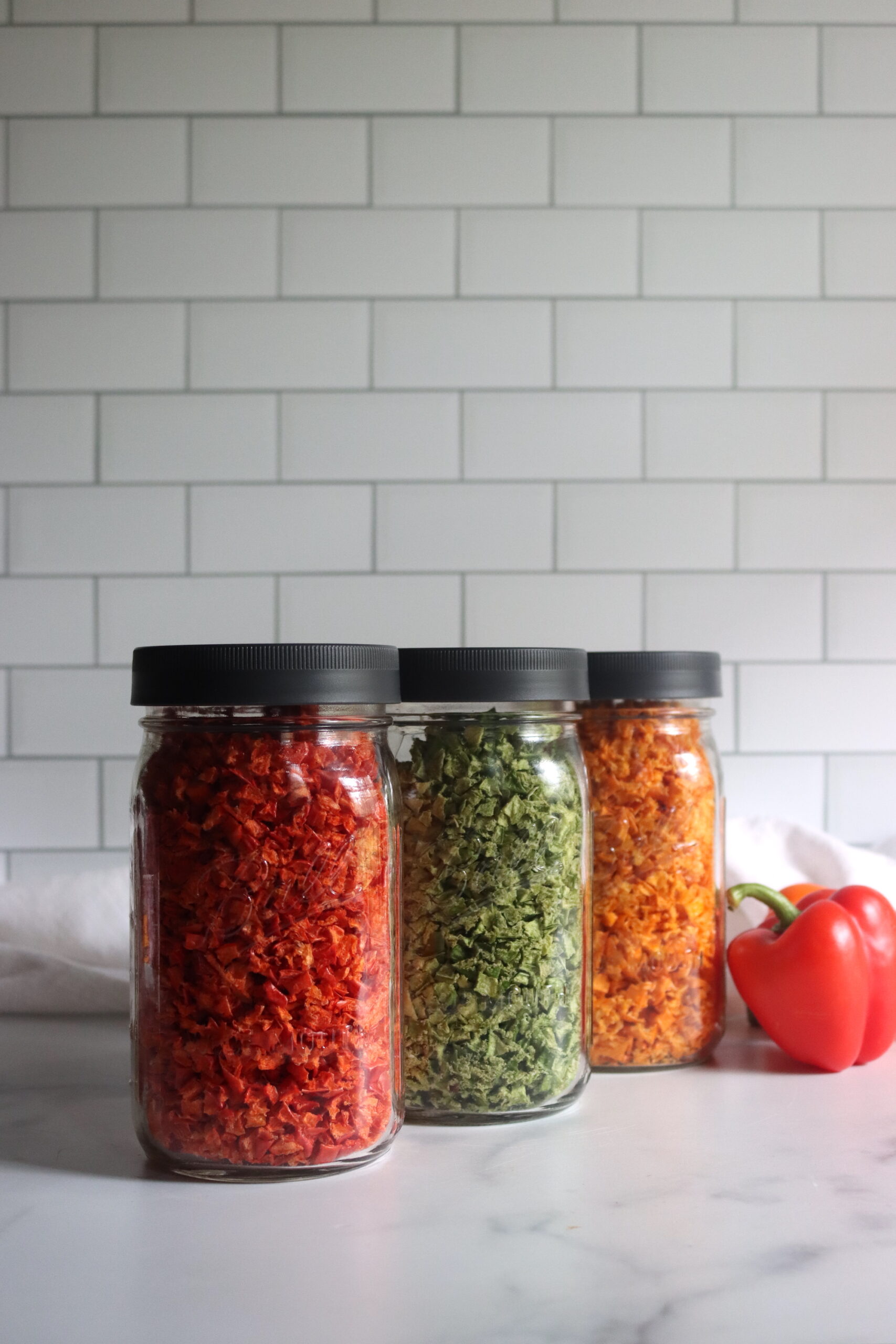
What’s the Difference Between Freeze Dried Peppers and Dehydrated Peppers?
Freeze-dried peppers are a thing entirely different from dehydrated peppers, with variations in texture, shelf life, and flavor.
Dehydrated peppers are leathery and bendable. Freeze-dried peppers are light and crispy. While dehydrated peppers shrink up, freeze-dried ones stay the same size. This is due to the different processes each method entails.
Dehydration uses heat to drive off moisture and preserve foods. This affects texture and taste, sometimes giving fruits and vegetables a cooked flavor. Freeze-drying, on the other hand, freezes foods to a very low level before vacuum-drying them. This process suspends the food at the exact state it was in when it was freeze-dried, just removing the water content and nothing else.
Freeze-dried foods are more flavorful than dehydrated ones and reconstitute better. Dehydrated peppers are still nice, but freeze-dried ones are something all their own!
Freeze-dried peppers retain color better, keep more nutrients and have a vastly longer shelf-life. While dehydrated, peppers last just a year or so, while freeze-dried ones last about 10 to 20 times longer! This is because freeze-drying removes about 98% of the water content in a food.
Freeze-dried bell peppers make a delicious sweet, crunchy snack right off the tray. And when rehydrated, peppers have even more uses!
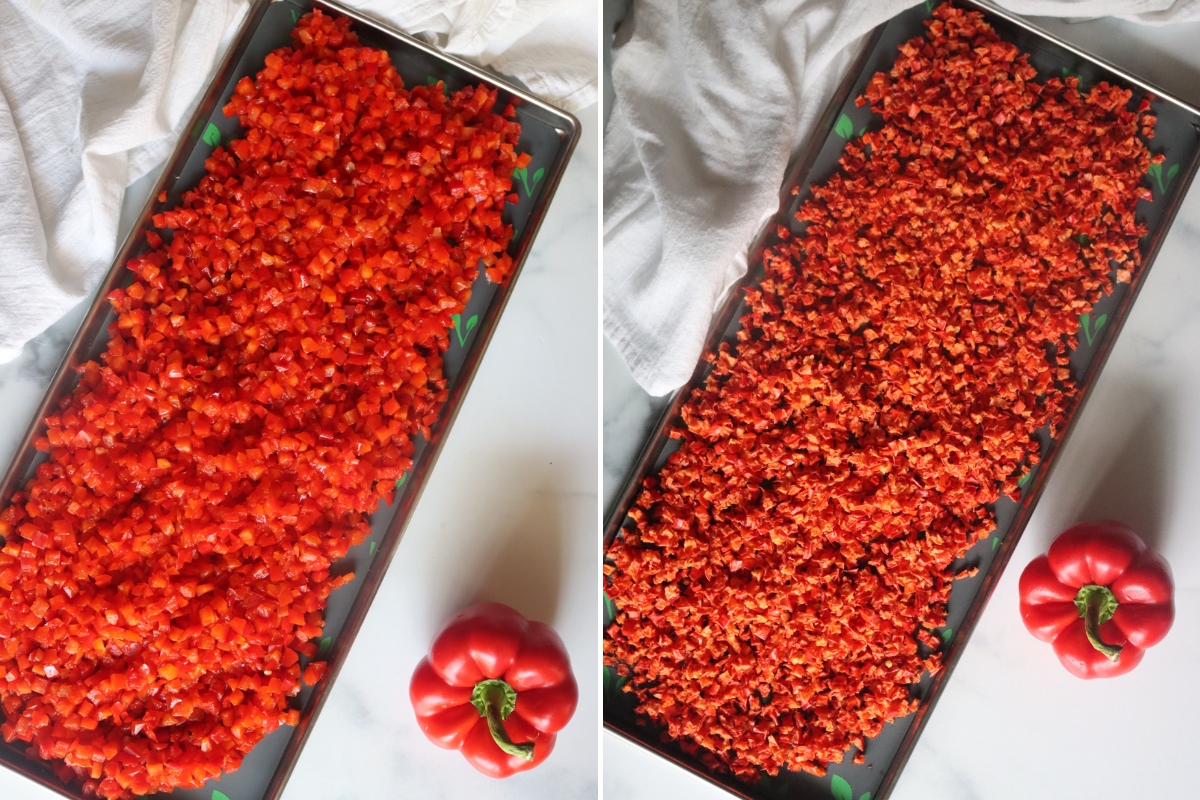
Best Peppers to Freeze Dry
For the best possible freeze-dried peppers, you want to use the highest quality produce. Bland or flavorless peppers won’t get any better once preserved, so stick to selecting fresh, plump peppers for the picking.
Choose peppers at the peak of ripeness. No matter the variety, peppers should have firm, glossy skin and no mushy spots.
If you pick your peppers up from a store rather than harvesting them yourself, try to select those that are locally grown. Peppers that have traveled far tend to be selected more for their shelf life than their flavor.
Give your peppers a sampling before freeze-drying to test their quality. How they taste now is how they should taste coming out, only in a drier crispier form.
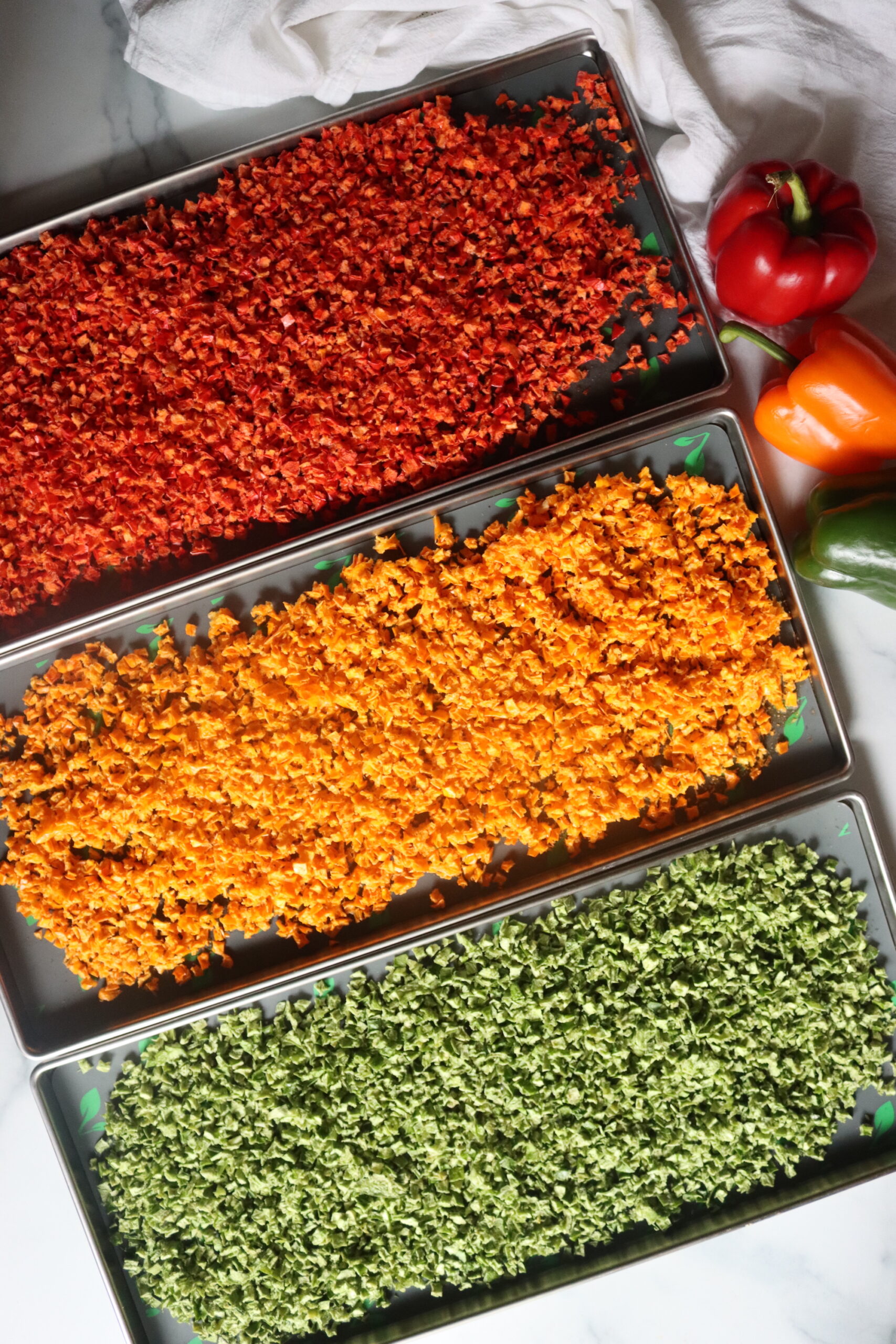
Freeze Dried Peppers Yield
Knowing how many peppers to purchase for freeze-drying can be tricky. How many you can fit per tray depends both on the size of the machine and the size of your peppers.
When it comes to bell peppers, 1 small pepper can be ¼ cup chopped, a medium pepper equal to about ½ cup chopped, and 1 large pepper equal to around a cup. A pound of peppers will be 3 to 4 cups all chopped up (equivalent to 3 large peppers or 5 medium).
When freeze-dried, peppers will stay the same size, so a cup of fresh peppers should yield a cup of freeze-dried peppers!
In my freeze dryer, I can technically fit 3 to 4 pounds per tray, as it’s rated for 15 to 20 pounds of food across 5 trays. I’ve actually found that 2 to 3 pounds works better. There may be less yield per batch, but the freeze-drying time is shorter.
Most freeze dryers are rated for a given amount of food. How much you can fit will depend on the tray dimensions and how heavily you plan to pack them. With diced foods, overlapping will be necessary — still, you should try not to pile food higher than the edges of the trays.
Here are the average yields of each freeze drying machine listed by size:
- Small Freeze Dryer: Processes 6 to 10 pounds of food per batch, across 4 trays (434 square inches of drying space).
- Medium Freeze Dryer: Processes 10 to 15 pounds of food per batch, across 5 trays (675 square inches of drying space).
- Large Freeze Dryer: Processes 18 to 27 pounds of food per batch, across 6 trays (1107 square inches of drying space).
- Extra Large Freeze Dryer: Processes 40 to 50 pounds of food per batch, across 7 trays (2257 square inches of drying space).
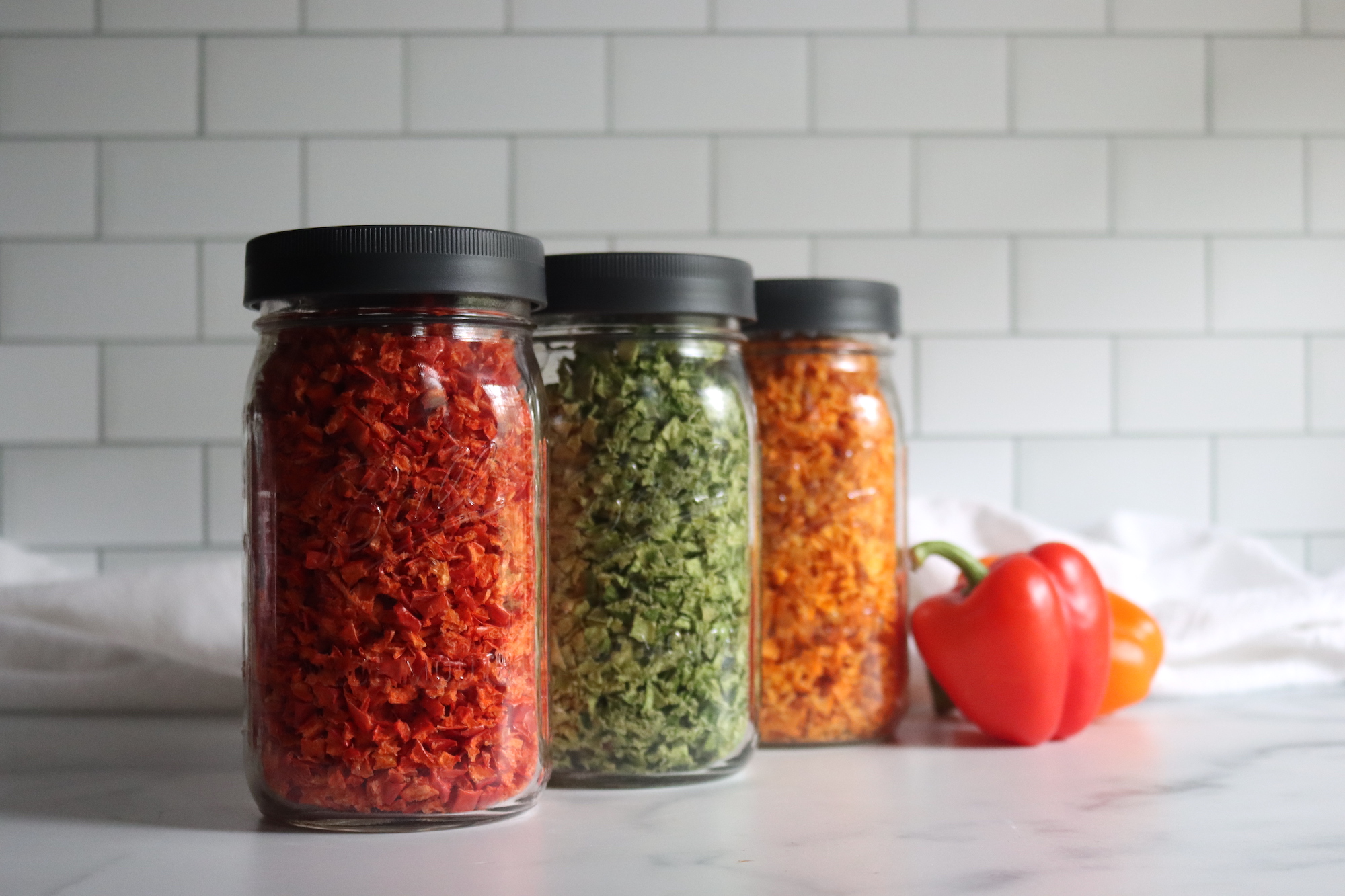
Supplies Needed
To freeze-dry peppers, these materials will be needed:
- Peppers – Hot or mild, sweet or spicy, the choice is yours!
- Home Freeze Dryer – The bigger machines actually cost less to operate per pound of finished food. So if it makes sense for you and your family, I’d recommend going for a larger model that holds more instead of running multiple batches in a smaller machine.
- Cutting Board and Knife – For slicing and dicing those peppers into nice uniformly-sized pieces. Peppers can also be cut into rounds, chopped up or halved.
- Silicone Tray Liners (or Parchment Paper) – Peppers can stick to trays and require prying to remove. Avoid this by lining freeze-drying trays with parchment paper or silicone liners.
- Colander and Towels – Washing peppers before freeze-drying will be needed to remove any residue. Placing peppers on towels after will help them to dry. (Drying is important since any excess water will extend your freeze-dry time.)
- Mason Jars (or Airtight Storage Containers) – Because freeze-dried peppers are so versatile, they rarely last more than a year in our home. As such, we keep them in mason jars. If you’d like to store foods for longer than a year, you will need Mylar bags with oxygen absorbers to complete the task.
- Vacuum Sealer (Optional) – An affordable vacuum sealer helps to remove as much oxygen as possible in mason jars, lengthening shelf life.
- Label Tape and a Pen – Especially with peppers, labeling is important. You don’t want to mix up your serranos with poblanos! Always label and date the contents of your food, be it in a mason jar or mylar bag.
Preparing Peppers for Freeze Drying
Preparing peppers for freeze-drying is incredibly easy. Simply chop peppers in whatever way you normally do before cooking them!
It’s the same process you’d use for making freeze dried onions or freeze dried tomatoes, and they work really well when diced, making them easy to rehydrate for using in stir fries, omelets, soup or atop pizza.
This is a great time for a food processor to help speed things up. My Breville Slice and Dice food processor dices peppers into 3 different sizes: 8mm, 12mm, or 16mm pieces (equal to ⅓ inch, ½ inch, and ⅔ inch cubes.) Using something like this can help you evenly and quickly cube peppers into perfectly sized chunks.
Peppers can also be sliced into longer strips for use in fajitas or sandwiches. Peppers like jalapeños can be sliced into little wheels to preserve all their spicy seeds. The choice is truly yours!
Just remember, try to keep the pieces uniform in size to promote even drying.
Additionally, when slicing hot peppers, always wear gloves. The capsaicin-filled oils of certain hot peppers can burn your skin.
Another tip: if you’re drying both sweet and hot peppers, consider slicing them differently to help you tell the two apart once they’re freeze-dried. Many homesteaders often dice bell peppers and slice hot peppers longwise for this reason.
If you like, you can pre-freeze your peppers at this point to shave off some time in the freeze-dryer. Pre-frozen foods will take less time to freeze-dry than those that are at room temperature.
Peppers can be frozen directly on trays if you have a deep freezer or in freezer bags if the pieces are large enough. If you go the freezer bag route, you will likely need to break pieces up before placing them on trays, so try to pack bags loosely.
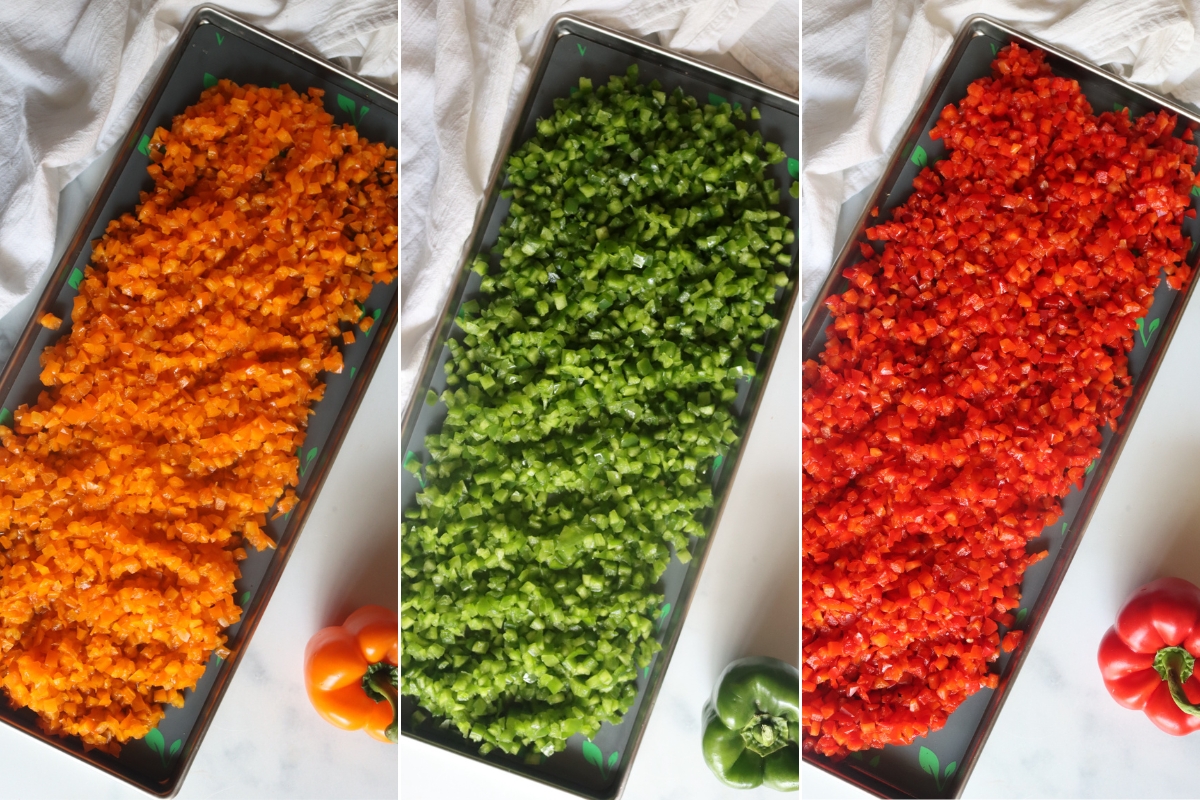
How to Freeze Dry Peppers
The freeze-drying process is easy once you’ve finished prepping your peppers.
To begin the freeze-drying process, start by turning your machine on and allowing it to pre-chill for 30 minutes.
Line your freeze-drying trays with silicone liners or parchment paper for easy cleanup, then arrange the chopped peppers on the trays.
As soon as your freeze-dryer is pre-chilled, you can pop those beauties in and press “continue.”
And that’s it! In about a day, you should come back to find several lovely trays of freeze-dried peppers.
How Long Does it Take to Freeze Dry Peppers?
On average it should take between 20 to 24 hours to freeze-dry a batch of peppers. Still, the time can vary from batch to batch based on a few factors. Some of these include:
- Pre-Freezing: If your peppers were at room temperature when they went into the freeze dryer they will take longer than if they were pre-frozen.
- Piece Size: Thicker chunks will take longer to freeze-dry than smaller pieces. If peppers are dried whole instead of sliced, they can take as much as twice as long.
- Moisture in the Produce: Peppers with a higher moisture content will take longer than those with lower ones, as more liquid must be removed to preserve them.
They wont take nearly as long to dry as fully liquid foods like freeze dried milk and freeze dried eggs, but they still have plenty of moisture.
How to Tell if Freeze Dried Peppers Are Done
Fully freeze-dried peppers will have a crunchy, airy texture. They will be hard and absent of all moisture. If you take a bite, they should be crispy and crunchy.
If you freeze-dried longer slices, they should easily snap in half. To test for dryness, take a large piece and break it. Check the middle for moisture. It should be firm and entirely dry.
If your peppers have any signs of moisture or ice, you will need to extend the drying cycle a little longer. Add a few more hours and remove only when fully dry.
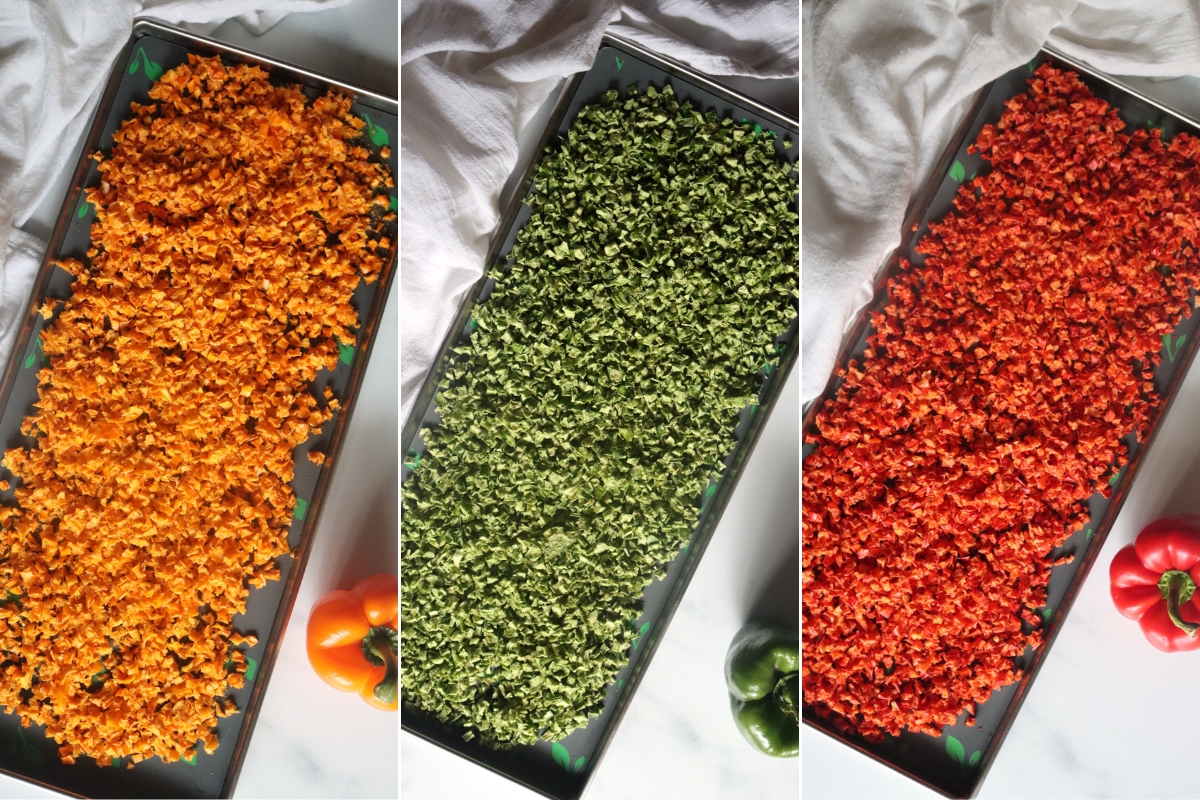
Reconstituting Freeze Dried Peppers
Although you can easily eat freeze-dried peppers as a snack (especially bell peppers) most choose to reconstitute them for cooking.
To rehydrate peppers back to their original plump form, place the desired amount in a bowl and top with warm water. Allow the peppers to soak up this liquid for about 20 minutes and use as fresh in your recipe.
Rehydrated peppers will not have the exact same texture, although it’s very close. The crunchy texture of fresh peppers will be somewhat lost. For this reason, I recommend cooking your freeze-dried peppers to get the most out of them.
How Do Freeze Dried Peppers Taste?
Freeze-dried peppers should taste exactly like fresh peppers, provided you picked them at the right stage. Freeze-drying doesn’t change the flavor of foods, it only removes the water content, basically fixing them at the stage they were when you processed them.
If you selected under-ripe peppers or those that were bland and flavorless, freeze-drying won’t do anything to fix that. They’ll still taste the same, only dry and crunchy, and a little more concentrated since the water has been removed.
Given this, be sure to always pick fresh, well-colored, and flavorful peppers for the absolute best freeze-dried food.
How to Store Freeze Dried Peppers
Planning on using peppers within the year? Storage in mason jars with tight-fitting lids will be fine then. If you’d like to keep them for multiple years, this calls for long-term storage.
To package freeze-dried peppers for extended storage, you will need to seal them in mylar pouches with oxygen absorbers.
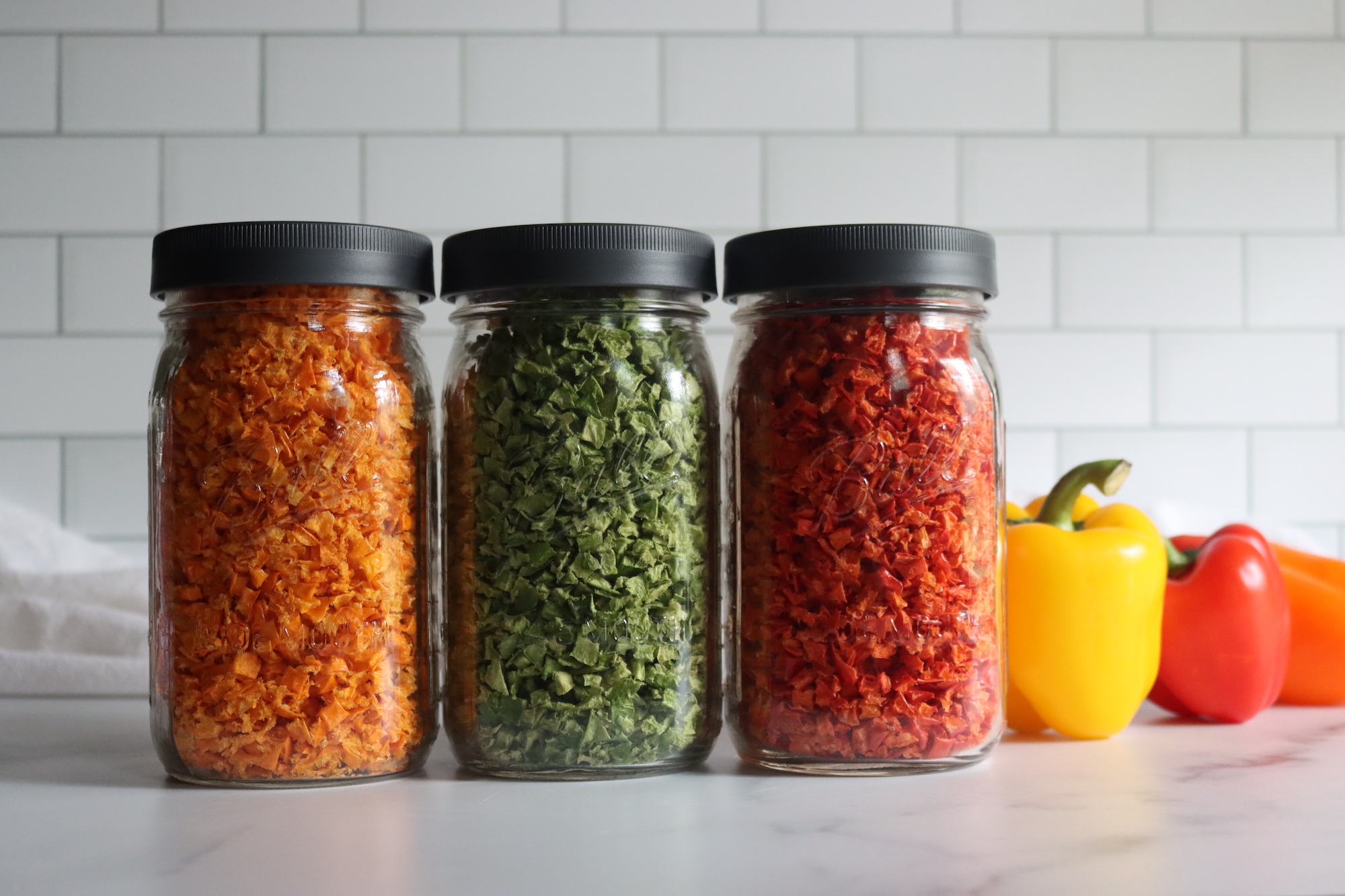
How Long Do Freeze Dried Peppers Last?
When packaged in mylar bags with oxygen absorbers, freeze-dried peppers can last 30+ years. If kept on the pantry shelf in an airtight container, they’ll keep their quality for 1 to 2 years max as long as the containers remain closed.
Once containers are opened, ambient humidity from the environment seeps in, reintroducing moisture to your preserved food and quickening its expiry date. For this reason, it is a good idea to store freeze-dried peppers in smaller jars that require opening less frequently.
Ways to Use Freeze Dried Peppers
Freeze-dried peppers are a versatile option to keep on the pantry shelf. Once rehydrated, they can be added to rice and pasta dishes, used in sautees or turned into salsa.
When in search of a refreshing snack consider using freeze-dried garden peppers to make a bell pepper salsa. For another great appetizer, consider using sweet peppers in a salad, such as this Ethiopian lentil salad.
Add those rehydrated peppers to omelets, frittatas or a lovely quiche for breakfast.
When dinner rolls around, consider popping those peppers into some exotic dishes like Turkish sautéed spiced lamb. Peppers are great additions to stir-fries as well. Try combining them with the flavors of beef or chicken for delightful results.
Want to skip reconstituting freeze-dried peppers altogether? Add them directly to soups and stews like this easy stuffed pepper soup recipe.
You can also grind up freeze-dried peppers in a spice grinder or food processor to make your own spicy seasoning. Grind up chilis, serranos and jalapenos, and then use like cayenne pepper to spice up meals!
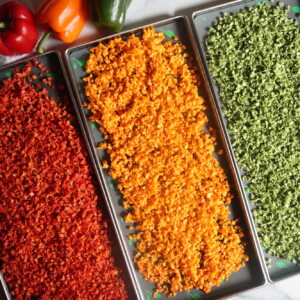
Freeze Dried Peppers (Hot or Sweet)
Ingredients
- Fresh or Frozen Peppers
Instructions
- Start by pre-chilling the freeze dryer for 30 minutes.
- Next, slice peppers into your desired shapes and sizes. You can cut peppers into rings, chop them into sections or dice them. (Smaller peppers can also be dried whole, but this will take longer.)
- (Optional) Line trays with silicone liners or parchment paper to prevent sticking.
- Spread your peppers on the freeze-drying trays. If chucks are large, arrange them in a single layer. If peppers are diced, try to keep the layer an even thickness and be sure to keep food below the edges of the tray.
- When the freeze dryer has pre-chilled, place the trays inside and close the door. Press “continue.”
- The freeze dryer will now run for a full cycle (usually 20 to 24 hours, but this can vary based on pepper size, moisture content and whether food is room temp or pre-frozen).
- Once the cycle is complete, test the peppers to ensure they are totally dry. They should be crispy and light. If they are not fully dry, extend the drying time by a few hours.
- When dry, remove peppers from the freeze dryer and set the freeze dryer to defrost.
- Pack the peppers away for storage promptly. Mason jars may be used for short-term storage. For long-term storage, seal peppers in mylar bags with oxygen absorbers.
- To rehydrate freeze-dried peppers, place the desired amount in a bowl and cover with water. Wait 20 to 30 minutes, then drain off the excess liquid. Once rehydrated, peppers must be refrigerated to prevent spoiling.
Notes
Pre-Freezing
Pre-freezing peppers can shorten the freeze-drying time. To pre-freeze peppers, wash and cut as desired, then freeze directly on trays or in freezer bags the day before planning to run your freeze dryer. Room temperature peppers will also freeze-dry perfectly fine, they will just take a bit longer!Freeze Drying Guides
Ways to Preserve Peppers
Whether you’re growing a bumper crop or stocking up in bulk, there are plenty of ways to preserve peppers for year-round use. Try canning peppers—either hot or sweet varieties—or spice things up with a jar of Cowboy Candy (Candied Jalapeños). If you’re looking for an easy pantry staple, pickled pepper recipes are always a hit.
You can also ferment them into your own fermented hot sauce for a probiotic kick, and fermented hot sauce always has more flavor than regular unfermented versions.
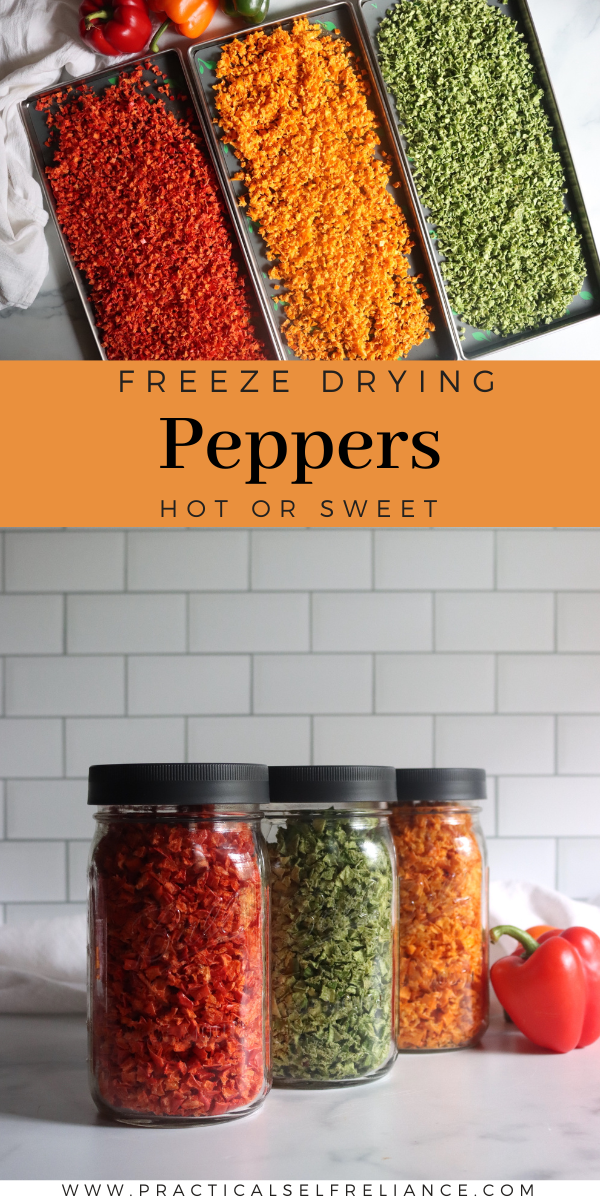
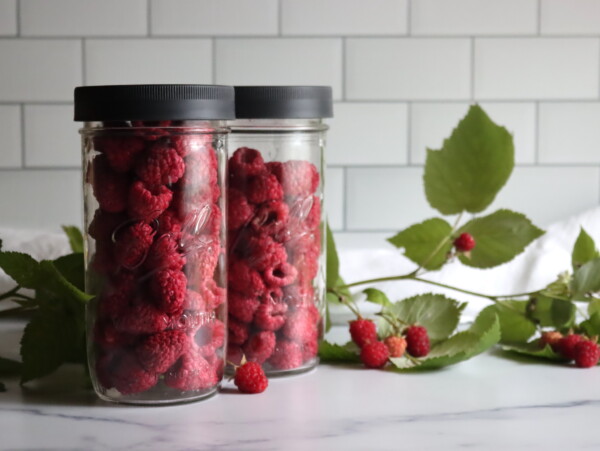
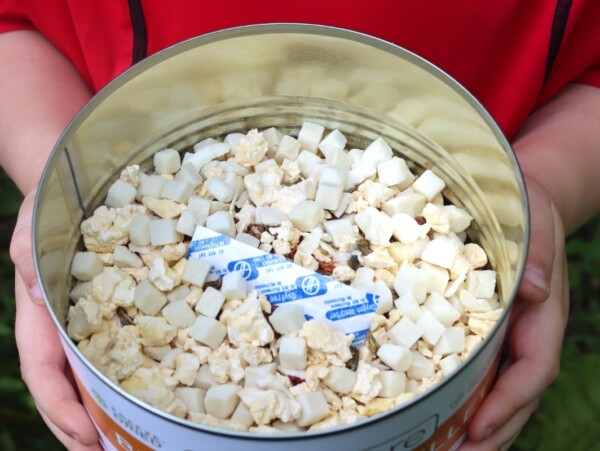
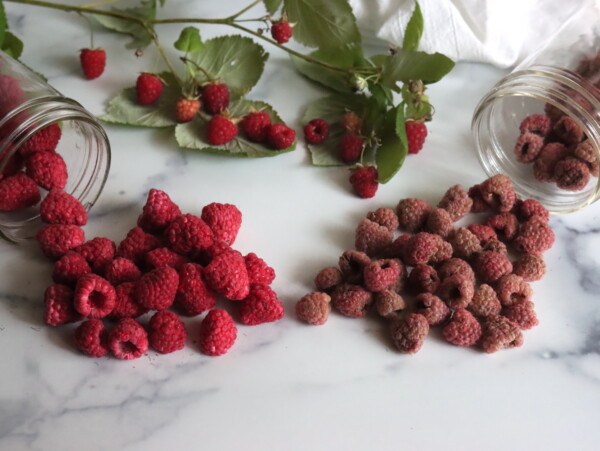
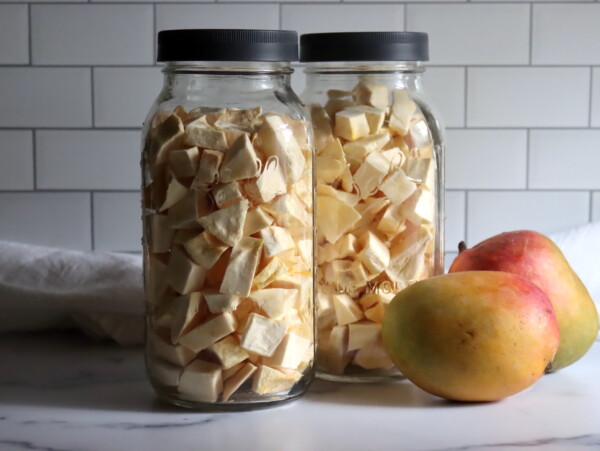
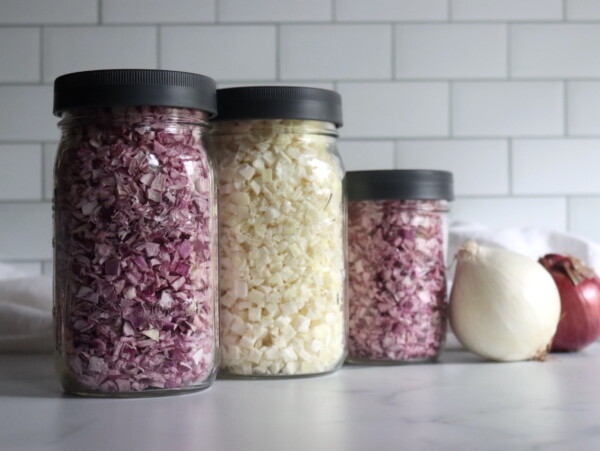
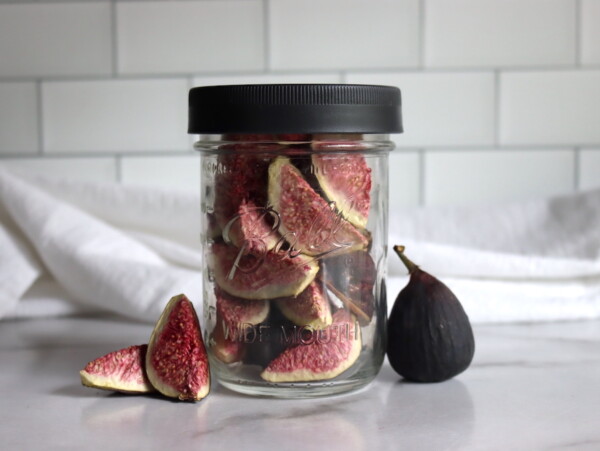
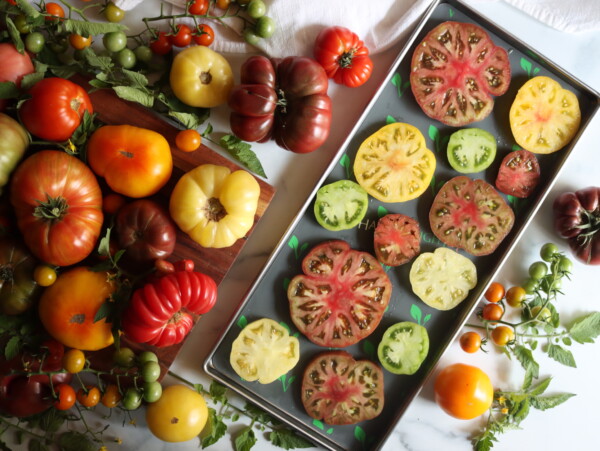
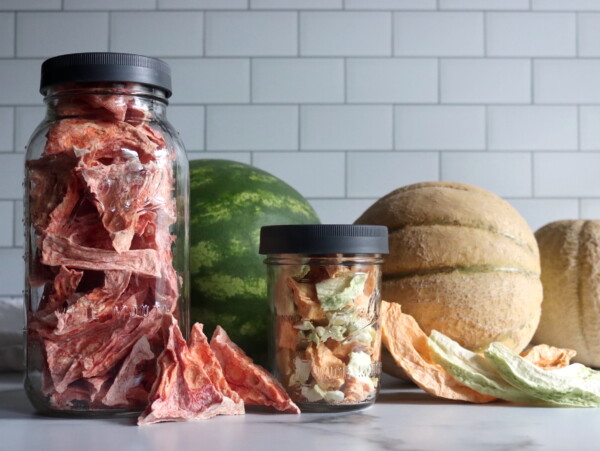










Can bell and poblano peppers be prepped for stuffing and then freeze dried?
Currently I cut off the tops of bell peppers or one side of poblano peppers and remove the ribs & seeds, then blanch them before sealing them in vacuum sealed bags (only remove a small amount of air or the peppers get smooshed) and then freeze.
I’m contemplating purchase of a freeze dryer so we don’t need to purchase an additional freezer or worry about power outages. Figuring out which of our garden produce can be freeze dried rather than frozen is part of the process.
The other space hogs in our freezer are sliced yellow squash and a variety of casseroles made with eggplant. I assume raw sliced yellow squash is perfect for freeze drying. And I’m hopeful eggplant slices roasted without oil can be freeze dried for later casserole making – although freeze drying raw and then roasting after rehydrating would not be a tragedy.
Appreciate any advice you can share – glad I found your website!
Yes, you should be able to freeze dry the peppers without issues.
Great! I worried that the size might be a problem since I assume the essentially whole peppers will be taller than the sides of the trays.
Care to share your thoughts on freeze drying yellow squash or eggplant?
As long as it’s a solid food and not a puree or liquid, it’s not usually an issue as long as they aren’t touching the bottoms of the trays above. Here are some recommendations that I found in a freeze drying group on Facebook from Harvest Right.
“Slice Thinly: Cut the eggplant into thin, even slices. Thinner slices will dry more evenly and thoroughly.
Blanching: Consider blanching the slices briefly in boiling water, then cooling them in ice water. This can help preserve color and texture.
Single Layer: Lay the slices in a single layer on the freeze dryer trays to ensure even drying.
Pre-Freeze: Pre-freeze the slices on the trays before starting the freeze-drying process. This can help speed up the process.”
I would use these same recommendations for the squash.
Thanks! Appreciate you passing along the info from the Facebook group since I don’t do Facebook.
It’s beginning to look like a freeze dryer might help preserve what we grow.
Wonderful!